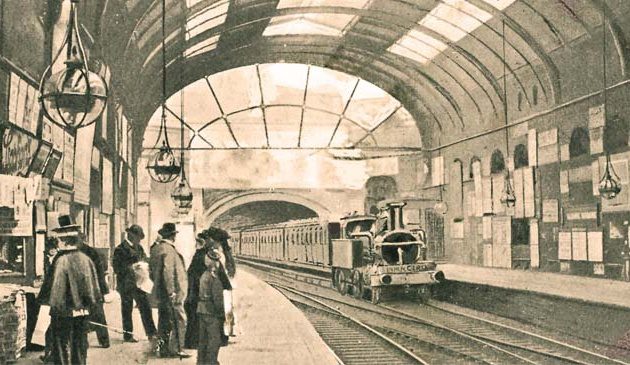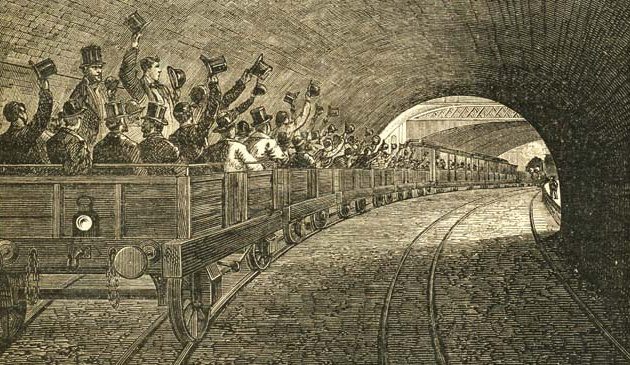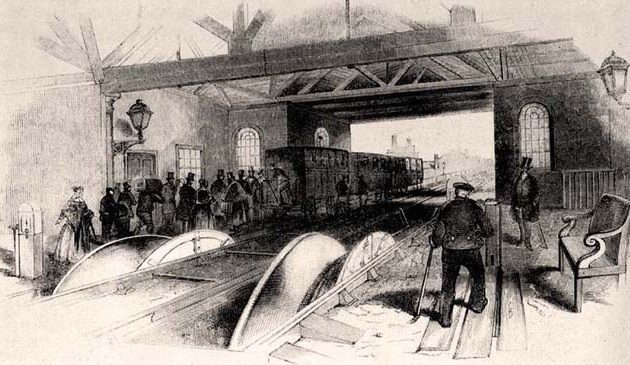London’s earliest long-distance railway

The entrance to the engine shed of the London & Birmingham Railway at Camden in 1838. This coloured lithograph was one of 50 made by the London artist John Cooke Bourne. He is best known for his pictures of the construction of the London & Birmingham and Great Western Railways, which were published in four volumes in 1838 and 1839. His interest in the railways was sparked when construction of the L&BR was taking place near his home.
To travel south from Camden involved crossing the Regent’s Canal. To tunnel under would have been expensive so it was decided to pass over it. That then required a steep incline for the short distance to Euston. An elegant iron bowstring suspension bridge was constructed over the canal, the first of its type. The engineering of the bridge was unproven and required much safety testing before construction. Several roads, either existing or planned, also crossed over the Extension, so seven bridges, some of brick and others of iron, were necessary. The canal bridge and most of the road bridges have since been replaced over time.
South of Camden the line passed through urban space that was more expensive to purchase than the rural areas further north. There were four tracks in the Camden to Euston section. To minimise expenditure a long, narrow, walled cutting was created from Park Street, now renamed Parkway, to Euston, with steep sides.
The 1835 Act allowed the company to construct the line from Camden to Euston but not necessarily run locomotives over it.
[The company should not] permit or suffer any other Person or Persons to fix, erect, or build or otherwise suffer to be worked or used, any Steam or other Engine, Forge or Manufactory, on any Part of the Land or Ground purchased of and conveyed to them by the said Charles Lord Southampton by the Deed Poll dated the Third Day of January One thousand eight hundred and thirty five, which may be or cause any Nuisance, Annoyance, Damage, or Disturbance to the said Charles Lord Southampton, his Heirs or Assigns, or any of his or their Lessees or Tenants in the said Parish of Saint Pancras, without first obtaining the Consent in Writing of the said Charles Lord Southampton, his Heirs or Assigns.
It was anyway found that locomotives did not always have sufficient power to rise up the steep incline, with their wheels slipping during rain. The site of Euston station was also too cramped for locomotives to turn around. The solution was that locomotives would start and end their journeys at Camden. The carriages of trains arriving at Camden then descended the incline to Euston by gravity, controlled by the carriage brakes. Trains departing Euston were hauled up the incline by tarred rope of 10,950 feet in length. A large building with two immensely high chimney stacks was erected at Camden to house steam-powered winding engines for the hauling. The procedure of hauling trains was quite swift, with the journey from Camden to Euston lasting only three or four minutes. Rope haulage continued until 1844, when the stationary engines were sold to a mill in Russia but locomotives struggled with the incline long into the 20th century.
The Camden terminus, where Camden Market is now located, was used for an engine shed large enough for 15 locomotives, and a goods terminus with warehouses and stabling.
Traffic on the railway steadily increased in the early years and the first locomotives were replaced by larger and more powerful engines. The Camden depot was rebuilt in 1846 with two buildings to separately handle passenger and goods engines. The goods engine depot was circular and contained a turntable into which 24 lines ran. It was only used for its original purpose for the first decade until it became too small to handle larger engines of the latter 1850s. Yet, it survives today as the ‘Roundhouse’ concert venue and has been protected as a National Heritage Site since 2010.
When the London & Birmingham Railway was being constructed there was no suitable way for communication along the line, to inform when a train was running late, or to warn of an accident. In June 1837 an experiment by Charles Wheatstone and Willian Fothergill Cooke took place to use a telegraph signal. A wire of a mile and a quarter was laid along the track from Euston to Camden. Although successful, it would have been an additional expense to run telegraph wires along the entire line. The directors were only prepared to do so if the Grand Junction Railway would do the same, but they refused. Shortly after, Isambard Kingdom Brunel introduced the system on the Great Western Railway and it thereafter became the standard on railways in many countries. It was finally introduced on the Birmingham railway after 1846.
The London terminus was initially known as ‘Euston Grove’. The original station was designed by Philip Hardwick and Charles Fox and built by Willian Cubitt. It consisted of two simple parallel sheds, one for arrivals and the other departures, with each containing two tracks. The departures shed was connected along its length to a plain two-storey building, the lower floors housing the booking office and upper floor containing offices for the railway.
In contrast to the station itself, fronting onto the New Road was a massive propylaeum entrance of the Doric order, designed by Hardwick, and completed in 1840. The 72-feet high ‘Euston Arch’, as it became known, was created at great expense to symbolise the ‘gateway to the north’. A matching frontage was built at the Birmingham terminus.
The L&BR had purchased land at the intersection of Euston Grove and Drummond Street. It was widened into a plaza named Euston Place. There the company commissioned Messrs. Grissell and Peto to create the world’s first two railway hotels each facing the other, which opened in September 1839. The Adelaide Hotel, later renamed the Euston, was the more luxurious, catering to first class passengers, while the Victoria Hotel offered basic dormitory facilities.


